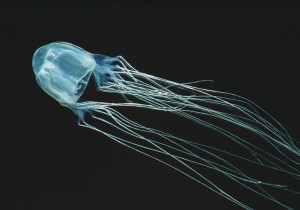Monster Monday: the Box Jellyfish
November 7, 2016
Under water, the box jellyfish is practically invisible. It is one of the most venomous animals on Earth. It kills more people each year than sharks do. At most, however, it weighs only about 4½ pounds (2 kilograms). This Monster Monday critter packs a lot of pain into a small package.

The sting of a box jellyfish can kill a person within minutes. Credit: © Visual&Written SL/Alamy Images
Chironex fleckeri, called the box jellyfish or sea wasp, is a dangerous stinging jellyfish found in the waters of northern Australia and Oceania. Similar species are also known as box jellyfish and have painful stings, but few are as painful as that of C. fleckeri. The creature has a box-shaped body that reaches about 15 inches (38 centimeters) across. The sea wasp has clusters of tentacles, with up to 15 tentacles in each cluster. The tentacles may reach about 10 feet (3 meters) in length. The tentacles contain billions of tiny capsules, many of which hold a poisoned barb.
Box jellyfish have sophisticated adaptations for active hunting that other jellyfish lack. Unlike other jellyfish, which usually float passively around in the current, the sea wasp swims at speeds of about 4 ½ miles (7 kilometers) per hour. The sea wasp has a whopping 24 eyes. Most of these are very simple sight organs called eyespots that detect light and shadow. But four are complex sight organs that possess corneas, lenses, and retinas. Researchers think sea wasps use these adaptations to spot and track down their prey, which includes shrimp and small fish.
Box jellyfish do not hunt large animals, but they do occasionally run into humans. Because box jellfish are translucent, it is practically impossible for people to see them and avoid them. People are usually stung without warning—an incredibly painful experience—while swimming or wading in the shallows. If the person is in poor health or suffers a bad sting with a large affected area, he or she may experience cardiac arrest and drown before reaching shore. Antivenin can counteract some the effects of stings. But because box jellyfish venom works so quickly, the antivenin must be administered within minutes for it to be of any use. Vinegar can be poured over the site of the sting to neutralize stinging cells that have not yet been activated. If the sting victim survives, the person may experience pain for weeks or even months after the initial contact.
Like other jellyfish, box jellyfish have increased in number and expanded their range in recent years. Scientists link their success to global warming and human damage to ocean environments. Most jellyfish live in warm water, so as climate change warms the oceans, jellyfish territory will slowly expand toward the poles. Overharvesting of the larger animals that usually eat box jellyfish (such as sea turtles) or compete with them for food are allowing jellyfish to spread unchecked. This could be bad news for beach goers everywhere.


